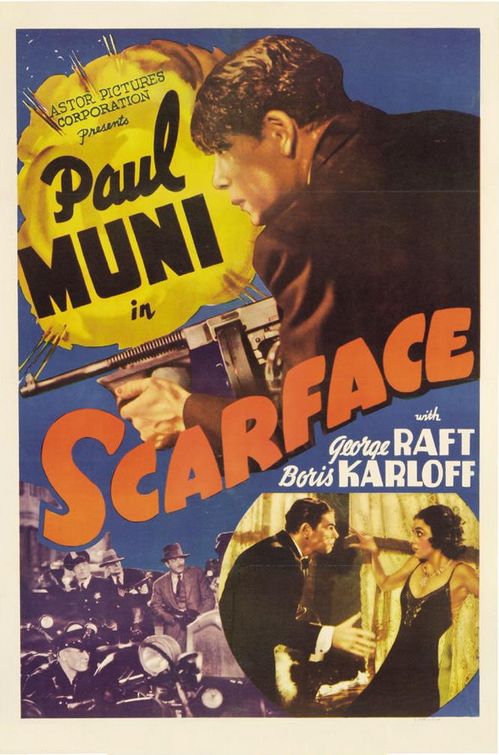 If you were to hear Scarface, you would immediately think of the classic Al Pacino movie as merciless Tony Montana who says so many F bombs in that movie. Matt’s Movie Reviews said, “Yet after watching the Howard Hughes produced, Howard Hawks directed 1932 gangster morality play original, Pacino et al. will become a faded memory when compared to this originator of violent gangster pictures, which has inspired crime illuminati’s Martin Scorsese, Francis Ford Coppola, and of course, Brian De Palma, who directed the 1983 remake.”
If you were to hear Scarface, you would immediately think of the classic Al Pacino movie as merciless Tony Montana who says so many F bombs in that movie. Matt’s Movie Reviews said, “Yet after watching the Howard Hughes produced, Howard Hawks directed 1932 gangster morality play original, Pacino et al. will become a faded memory when compared to this originator of violent gangster pictures, which has inspired crime illuminati’s Martin Scorsese, Francis Ford Coppola, and of course, Brian De Palma, who directed the 1983 remake.”
Loosely based on the abuses of famous gangster Al Capone, who was the king of the main streets of Chicago during the prevention era of the 1920’s, “Scarface” focuses on the rise and fall of vicious criminal Tony Camonte, a new class of gun-yielding gangster who lives by the faith “Do it first, do it yourself, and keep on doing it.”
Camonte was played by celebrated 1930’s character actor Paul Muni, with the entire splendor he could gather together. This was to be expected. Matt stated, “With such a flashy character, an equally flashy performance is needed, and Muni provides an exceptional example on how to play over the top without losing his characters emotional grounding.” Strangely enough, the only actor that could pull this off as well as Muni would be Pacino.
The beginning of this film has Camonte playing hitman for mob boss Johnny Lovo, played by Oswood Perkins. However, his superior goals for power quickly see him climb to the top of the Chicago mafia, taking out Lovo and stealing his girlfriend, played by Karen Morley, at the same time. However, his brutal love for his sister Cesca (Ann Dvorak) puts everything on the line when she falls in love with Camonte’s right hand man, Rinaldo (George Raft).
When watching “Scarface,” you must understand that this film is a product of its time. It’s illustrations of Italian American’s in particular relies strongly on stereotype, even in its use of speech, with “eh?” put at the end of each sentence. For instance, “I gotta do this; I gotta do that, eh?”
Matt stated, “Also, while the films violence is tame compared to the intense standards of today’s cinema, one must also appreciate that Scarface circa 1932 was a very violent film for its time, which brought on the wrath on censors and saw producer Howard Hughes battling the Hays Office and regional censor boards, delaying the films release for up to a year. So viewing the film in a historical context is a must.”
However, this does not discourage from the fact that “Scarface” is a largely entertaining film because of its daring, over-spending, gripping plot developments, and strong emotional centre, mainly the relationship between Camonte and his sister, which is developed further in the 1983 remake.
When you look outside of Muni’s performance, the most memorable element of “Scarface” has to be Howard Hawks’ brilliant direction and use of visual symbolic touches: a dead body bent on the corner of Under and Taker Streets. The use of the letter “X” as a visionary about death. The use of shadow (thanks to cinematographers Lee Garmes and L. William O’Connell).
Matt ends his review by saying, “A trend setter and instigator, dated in some parts, ageless in many others, Scarface is essential viewing not only for lovers of crime movies, but for lovers of cinema.”
In the end, see this movie because it’s one of the best. It’s a classic 1930s movie that you should definitely check out when you have the chance. Do you want to know what I thought of the famous 1983 remake? Stay tuned this Friday to find out.
No comments:
Post a Comment